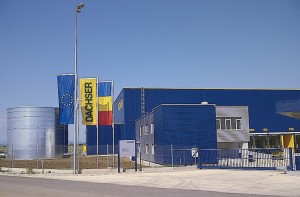Dachser strengthens its European network with one of the most modern dangerous goods warehouses in the region
 Kempten/Ploiesti, January 10, 2012. Dachser has opened a dangerous goods warehouse near Bucharest with an area of approximately 6,500 square metres and 11,500 pallet spaces. As currently the only warehouse in Romania, the facility, with an investment volume in excess of ten million euros, complies with the Seveso II Directive (96/82/EC).
Kempten/Ploiesti, January 10, 2012. Dachser has opened a dangerous goods warehouse near Bucharest with an area of approximately 6,500 square metres and 11,500 pallet spaces. As currently the only warehouse in Romania, the facility, with an investment volume in excess of ten million euros, complies with the Seveso II Directive (96/82/EC).
“The facility in Ploiesti is a flagship project in the expansion of our European logistics network,” comments Michael Schilling, managing director European Network Management & Logistics Systems at Dachser. “With this commitment, Dachser is setting standards for the entire growth region.”
Dachser Romania has constructed the warehouse with the support of Liegl & Dachser. The Hungarian joint venture has operated a dangerous goods warehouse in compliance with the strict Seveso II Directive in Pilisvörösvár near Budapest since 2006.
Engelbert Liegl, managing director of Liegl & Dachser Hungary, explains: “In combination with the excellent connection to the Dachser Eurohub in Bratislava, we are able to offer international customers from the chemical industry efficient and safe contract logistics for the entire region”.
State-of-the-art technology
Dangerous goods in the VCI dangerous goods classes 2, 3, 4.1, 6.1, 8, 10–13 can be stored safely in Ploiesti. The facility is divided into six fire protection zones separated by fire protection walls and doors. Sprinklers with foam mixing system are installed at each storage level. The dangerous goods warehouse is also equipped with fire alarm systems and sensors for combustible and toxic volatile substances. The warehouse floor is waterproof and repels oil and chemicals.
Dachser stores twice as much extinguishing water in Ploiesti as is legally required. Tanks and lines to the warehouse can be heated when temperatures fall below zero. Two special 2,000-cubic-metre concrete retaining basins beneath the facility ensure that not a single drop of contaminated extinguishing water or liquids escaping as a result of accidents or damage can seep into the ground. The high shelves can withstand earthquakes up to a magnitude of 8 on the Richter scale. Additional stability is guaranteed by supplementary metal clips and twice the amount of steel as is usually used. These measures are unique in any racking system in Europe.
“The new warehouse underscores our dangerous goods competence. The safety measures are in line with the latest technological standards,” explains Steve Heidner, Central Dangerous Goods Management at Dachser.
About Dachser:
Dachser (www.dachser.com) has been present with its own country organization at four locations in Romania since 2009: Bucharest, Arad, Brasov and now in Ploiesti. In 2010, the internationally operating logistics provider generated total revenue of EUR 3.8 billion worldwide. 19,250 staff working in 310 profit centres worldwide handled 46.2 million consignments weighing a total of 35.5 million tonnes.
For more information about Dachser’s dedicated services for the chemical industry visit http://www.chem-logistics.com
Background information: Expertise in Dangerous Goods Handling
Safety comes first. According to this motto, Dachser has implemented safety and quality standards for the storage and transport of dangerous goods above and beyond the legal requirements. Dachser’s dangerous goods regulations constitute a standardized, in-house guideline that defines transport prohibitions for certain dangerous goods, as well as risk evaluations, for all European branch offices. Locations are carefully inspected by Dachser’s central dangerous goods management team before being approved for the transport and storage of dangerous goods. At regional level, Dachser employs an additional 122 dangerous goods safety advisors, who share their expertise with over 6,000 participants a year within the context of in-house training courses. Furthermore, 14 Dachser locations in Europe have been successfully assessed by independent assessors on the basis of the CEFIC “Transport Service” questionnaire (SQAS).






